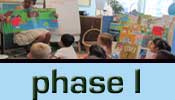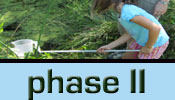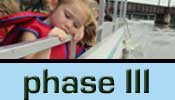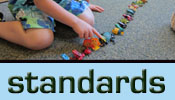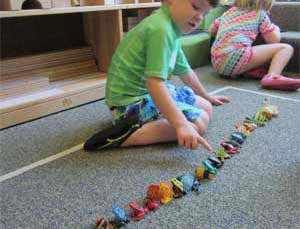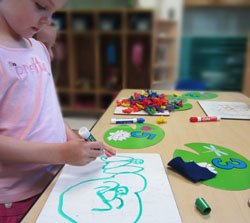
Standards
Teachers used the Maryland State Curriculum Standards as guidelines to consider when formulating lesson plans. Because the study was extremely science rich, it was easy to see where the activities fit in with the State Curriculum standards.
Science
Constructing Knowledge
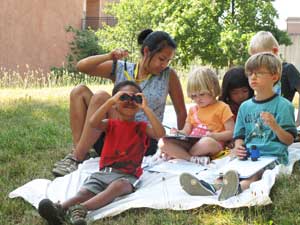 In the initial Phase of the Pond and Stream Life Study, children raised questions on the topic. These questions were recorded, displayed, and referred to throughout the study. When asked how they could find the answers to these questions, a list was generated by the students to include, field trips, books and scientists.
In the initial Phase of the Pond and Stream Life Study, children raised questions on the topic. These questions were recorded, displayed, and referred to throughout the study. When asked how they could find the answers to these questions, a list was generated by the students to include, field trips, books and scientists.
During Phase II children explored different bodies of water, brought back samples, checked field guides and consulted experts to answer their questions. One boy asked "Do streams have beaches?" This was easy to answer after a trip to the local stream. A girl wanted to know how the water got so dirty. After the Environmental Students came to talk, she found out that people, factories and farming dirty the water.
Some tools used during the investigation were nets, fishing poles, magnifying glasses, binoculars, pipettes, Petri dishes and an aquarium bubbler to keep the fish alive.
Reading and Writing
Understand that speech can be written and read . Compose oral and visual presentations that express personal ideas .
 Throughout the study, charts, letters, and lists were created with the children during group and independent time. Thank you letters were written to all visitors with words generated during group time and written on chart paper. Other lists that were written and read included questions, what to bring on the field trips, and common words used within the study.
Throughout the study, charts, letters, and lists were created with the children during group and independent time. Thank you letters were written to all visitors with words generated during group time and written on chart paper. Other lists that were written and read included questions, what to bring on the field trips, and common words used within the study.
Children did their own drawings of the ponds and streams and were able to share with the class during group time. Paper, markers, crayons, wipe off boards, personal journals and pencils were available at all times throughout the room to encourage the expression of personal ideas.
Fine Arts
Use selected works of art as inspiration to express ideas visually and verbally
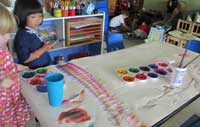
After reading a little about Monet and his water garden inspiration, the children had an opportunity to create their own Monet style painting on large sheets off paper. This became a collaborative effort since more than one child could work on the large paintings at a time.
Social Studies
Locate, retrieve, and use information from various sources to accomplish a purpose.
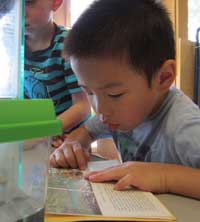 When asked how they could find the answers to the questions that were generated on the study topic this objective was realized. With help from the teachers, experts were contacted, a video was viewed on pond life and field trips were planned. The computer was used to search images of pond/stream life for the models children created.
When asked how they could find the answers to the questions that were generated on the study topic this objective was realized. With help from the teachers, experts were contacted, a video was viewed on pond life and field trips were planned. The computer was used to search images of pond/stream life for the models children created.
Informational books were abundant in the classroom for casual browsing and teachers were available to read independent selections most of the day. Many children became proficient at using the Audubon field guides by looking first for the silhouette of the animal and then to search in that portion of the book for an image that matched what they had seen.
Applying Evidence and Reasoning and Communicating Scientific Information
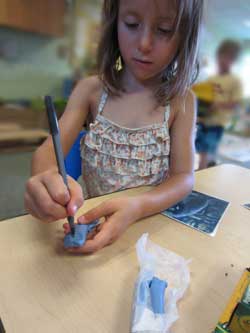 The Green Room children shared observations and drawings during group time. They compared the pond and creek with a Venn diagram. There was some discussion as to whether there was poison ivy at both locations and which area of the diagram to put other observations.
The Green Room children shared observations and drawings during group time. They compared the pond and creek with a Venn diagram. There was some discussion as to whether there was poison ivy at both locations and which area of the diagram to put other observations.
The children caught tadpoles at the pond and fish at the creek. Some children thought the tadpoles were fish. This resulted in a lively disagreement. Some of the dialog that ensued was:
" Is it a tadpole?"
" I think it is. It has a short tail on to and it's head is a round oval and the very last part of its tail is a little pointy."
"A tadpole doesn't have fins a fish does."
One boy had studied fish the last semester in his previous class. He announced that fish have fins and tadpoles do not. Another boy had studied tadpoles and could easily identify them, letting his classmates know that they would turn into frogs. Books were used to help with the decision.
Children created sculptures of some of the life they had viewed. Using field guides, computer images, photographs and memory, each child carefully crafted a model with varying degrees of detail. One girl remembered to put the "whiskers" she had seen on a catfish. A boy carefully replicated a pattern found on a Copperhead snake he saw in a field guide.
Technology
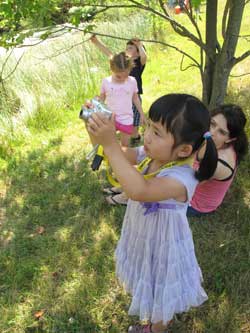
Because it was difficult to reach the water in the pond, a cup was taped to two different extensions rods. One was a dowel rod, the other a metal curtain rod. Children easily found out that the curtain rod was not sturdy enough and after retrieving a cup of pond water, the rod flipped and dumped it out. After that the first choice for dipping water was the cup attached to the dowel rod.
At the National Wildlife Center, children were able to explore many different models of habitats. When the children pushed a button or turned a crank, birds or other animals popped out. Children expressed that they learned what a snapping turtle skull looked like and where a dessert turtle lived after visiting the exhibit.
Letting the children take pictures with a digital camera and then printing them for a display allowed them to experience documentation in this way.
Diversity of Life
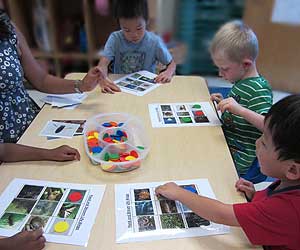 The Green Room was fortunate enough to have first hand experiences with four different kinds of turtles. A bingo type game with images of these and other pond and stream life they had encountered was used to reinforce the children's ability to discern the diffident types.
The Green Room was fortunate enough to have first hand experiences with four different kinds of turtles. A bingo type game with images of these and other pond and stream life they had encountered was used to reinforce the children's ability to discern the diffident types.
During the visit from a UM Biologist, children discussed what all living things need (food, shelter, water, air). While examining the mud worms she brought in, they found out they ate mud and were the prey for other animals like crayfish and fish. They learned during close observations, that the worms wiggle their segments to move .
While observing the three tadpoles caught at the pond and reading frog and studying frog tadpole models, children learned that frogs start out very differently from their adult form.
Environmental Science
Recognize and describe that the activities of individuals or groups of individuals can affect the environment.
The children became concerned about the amount of trash they saw in every body of water visited. After the UM Environmental Students visited, the children made a story about the trash in the water. Each child expressed what was important about keeping the ponds and streams clean. Most said to keep the fish from getting sick but it was apparent that the aesthetic display of trash was a problem too.
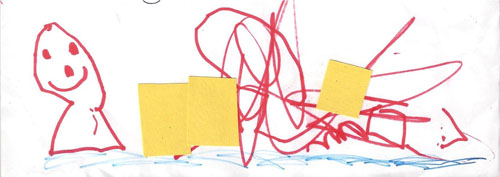
Mathematics |
|
|
Essential Skills and Knowledge • Ability to apply the strategies of touching objects as they are counted and by organizing the objects in a row Collections of frogs, fish, insects and other items were abundant in the room. This gave children multiple opportunities to sort, compare, count and arrange these attractive manipulatives. |
• Ability to distinguish Examples and non-examples of various shapes. The insects pictured right, represent some of the bugs children encountered during the study. This set of insects was sorted by different characteristics. With the teacher's guidance, children orally compared the sets by color, shape, size, type and quantity. A teacher asked this student, "Are there more butterflies or caterpillars?" |
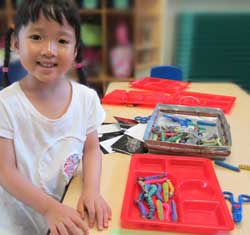 |
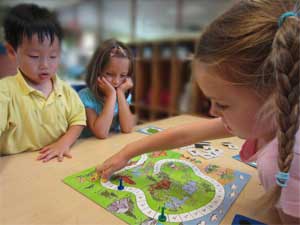 |
• Ability to build sets with concrete materials to show a given amount In the game pictured at left, children collect insects as they went around the board. Each space they land on tells them to either collect a certain number of bugs (1-3) or to put back a certain number (subtract). As insects were collected they were placed in a "jar". After finishing the path, jars of bugs were counted and compared. |
• Ability to represent sets with drawings which will lead to the ability to subitize The game on the left involved children in placing the correct number of frogs on each lily pad. This game quickly became redundant and children started making their own lily pads. The teacher encouraged children that were ready to make two lily pads and play a game where the amount of frogs on each pad were added together. |
|


